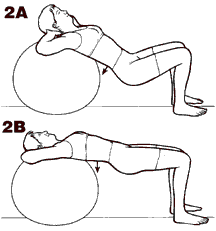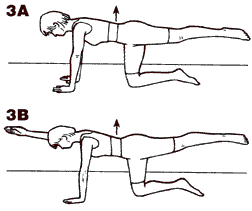Examples
Examples of the training approach for specific weak links are shown here. The continuum of care is important to follow for efficient results. It is wise to first offer simple advice to reduce strain on the biomechanical system that is overloaded. Generally, mobilization of areas of stiffness related to the "weak link" are addressed prior to initiating endurance or strengthening exercises. Such mobilization might include joint adjustments or release of adverse tension in muscles, fascia, skin, nerve, or joint capsules which is related to the biomechanical chain in which the "weak link" is located. Usually, weakness or lack of endurance is associated with poor motor control of a joint's "neutral range." This is often secondary to stiffness elsewhere in the kinetic chain.
Training the Gluteus Maximus
Indication
Typical clinical symptom complex: low back pain
Typical diagnosis: facet syndrome
Typical positive functional tests: hip extension test (see Figure 1); anterior pelvic tilt in standing posture or with gait; poor squatting endurance.
Exercise Prescription
Goals are to address:
weakness -- gluteus maximus
hypertonicity -- hamstrings, hip flexors, erector spinae
Continuum of Care:
Key advice: appropriate lifting strategy, in/out of chair, gait re-education;
Key manipulation: anterior hip joint capsule, T/L junction, fibular head, feet

Key relaxation or stretching exercises: iliopsoas, rectus femoris (femoral nerve mobilization), hamstrings (sciatic nerve mobilization), erector spinae;
Other perpetuating factors: hyperpronation syndrome;
Key facilitation exercises: posterior pelvic tilts; bridges (see Figures 2A and 2B); leg extensions; balance training on a rocker board in the sagittal plane; squats; lunges.
Health Club Tips
Avoid lumbar overstress during the following exercises.
- prone hamstring curl
- multi-hip machine
Training the Trunk Extensors
Indication: fail the Sorensen back extensor endurance test.
Exercise Prescription
Goal
- Facilitate -- multifidus, gluteus maximus
- Relax/release -- erector spinae, hamstrings
Continuum of Care
Key joints to manipulate: hip joints extension, T/L junction;
Key relaxation or flexibility exercises: iliopsoas, erector spinae;
Key facilitation exercises: abdominal hollowing; leg raises (see Figures 3A and 3B); back extension;
Other perpetuating factors: repetitive lifting or bending at work.
Health Club Tips
Avoiding lumbar hyperextension during Roman chair exercises isimportant.
When using exercise in your practice, it is wise to choose your goals carefully. Exercise can be time-consuming. Find the key "weak link" that is related to biomechanical overload of the pain generators. Pick a simple exercise or two which the patient can learn to perform with good form while building endurance. The quality of the exercise is more important than its quantity. However, to achieve a training effect, the exercise must be to the patient's threshold.
To distinguish training from merely activity, a few exercise science principles should be understood and applied. Threshold, frequency and duration of exercise must be appropriately incorporated into your use of exercise. To train endurance of a muscle's postural control function, a realistic goal is for the patient to be able to perform 10 repetitions of about 10 seconds each. Many patients may have no trouble with the first few repetitions but will be at their threshold long before 10 repetitions are achieved.
While resistance should be submaximal, the patient should demonstrate that tonic control is maintained and jerky (phasic) movements are avoided. When a patient can easily perform 10 repetitions with 10 second holds, they should then progress to a more challenging exercise. The frequency of such a training program should be daily, and the duration may need to be for at least three months.1
A great difficulty in integrating exercise into chiropractic practice is believing that you should spend a lot of time with your patients or prescribe numerous different exercises. Try to keep the rehab plan simple and emphasize that your patients are learning how to self-treat.
Outcomes Management
Documenting progress with care is essential for appropriate case management. Key goals for care include pain relief, activity intolerance reduction and functional restoration. Simple, inexpensive outcomes which are reliable, responsive, have a normative database and are safe should be used. The visual analog scale can be used to monitor improvements in pain severity. Questionnaires such as the Oswestry, Neck Disability Index or Roland-Morris can be used to monitor progress in reducing activity intolerances. Physical capacity tests such as range of motion (inclinometric); endurance tests (static trunk extensor; squatting; horizontal side bridge); balance tests (one leg standing) or cardiovascular fitness (Harvard step test) can be utilized.
Additional outcomes of care include such things as return to work, cost of care, customer satisfaction, medication usage and psychosocial status. Simple tools can be used to reliably capture this data as well.
Summary
Rehabilitation should be combined with manipulation and simple advice to manage troublesome back pain. The biopsychosocial and biomechanical models are both essential to improved patient care. Not every patient requires a great concentration of resources be allocated to them. However, all patients deserve that an algorithm of care be in place to handle their unique needs.
A new videotape series is available to aid in transitioning your patients from passive care (manipulation) to active care (exercise). Four tapes are designed to show clinicians how to make lumbar and cervical rehabilitation prescriptions and carry out flexibility (postisometric relaxation) and strengthening (spinal stabilization) prescriptions.2-5 An additional four videotapes can help motivate patients to perform home routines. They address acute care, flexibility/relaxation and gym ball routines.6-9
References
- Manniche C, Lundberg E, et al. Intensive dynamic back exercises for chronic low back pain. Pain 1991;47:53-63.
- Liebenson C, Chapman S. Rehabilitation of the Spine: Functional Evaluation of the Lumbar Spine. Baltimore: Williams & Wilkins, 1998.
- Liebenson C, DeFranca C, Lefebvre R. Rehabilitation of the Spine: Functional Evaluation of the Cervical Spine. Baltimore: Williams & Wilkins, 1998.
- Liebenson C, Murphy D. Rehabilitation of the Spine: Post-Isometric Relaxation Techniques. Baltimore: Williams & Wilkins, 1998.
- Liebenson C, Gluck N, Hyman J. Rehabilitation of the Spine: Spinal Stabilization Training. Baltimore: Williams & Wilkins, 1998.
- Liebenson C, Chapman S. "Safe Back Workout: Low Back Remobilization and Reactivation" (videotape, beginning level).
- Liebenson C, Perri M, Murphy D, DeFranca C. "Safe Back Workout: Flexibility, Breathing and Relaxation Routine" (videotape). Baltimore: Williams & Wilkins, 1998.
- Liebenson C, DeFranca C, Gluck N, Perri M. "Safe Back Workout: Low Back and Abdominals" (videotape). Baltimore: Williams & Wilkins, 1998.
- Liebenson C, DeFranca C, Gluck N, Perri M. "Safe Back Workout: Glutes and Thighs" (videotape). Baltimore: Williams & Wilkins, 1998.
Click here for previous articles by Craig Liebenson, DC.







